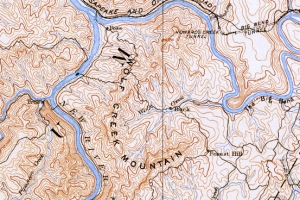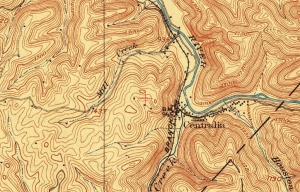
The Wolf Moon of January recalls a time when the howls of wolves haunted the Mountain State, the final eastern stronghold in the U.S. for the Canis lupus.
As far as is known, the last eastern wolf roamed the remote Allegheny Mountains in east-central West Virginia until it was shot and killed in Webster County in 1897 by 17-year-old Daniel Stoffer Hamrick.
Elsewhere, wolves had already disappeared from more developed surrounding states and had been purposely eradicated in Ohio by 1842 and Pennsylvania by 1892, but the mountains of West Virginia provided the last respite for the fearsome canines.
Though biologists now value the species, humans removed them from much of the northern hemisphere, largely because of conflicts with domesticated animals. Certainly, in West Virginia, they presented problems.
Sheep husbandry in West Virginia was known to have suffered particularly in the mountains and the interior and particularly in Braxton, Webster, Randolph, Greenbrier, Nicholas, and Pocahontas counties.
Native populations in the U.S. now remain only in the northern Rocky Mountains, in southern Arizona and New Mexico, and in the northernmost Great Lakes region.
Wolf Names in West Virginia
Though the wolf may have passed beyond memory in West Virginia, its name has not. At least 32 placenames that include the word "wolf" appear in state registers, and most of these are located within its mountainous interior—the last stronghold of the gray ghosts.

For instance, there's a Wolf Creek Mountain in Summers County and another in Monroe, and a Wolf Fork Mountain in Lewis County. There's a Wolf Hill in Morgan County and a Wolf Gap in Pretty Ridge in Wyoming County.
There was also a Wolf Bar in the Ohio River in Mason County, long ago drowned by the lock-and-dam system on the river.
There are seven Wolf Creeks — a tributary of the Elk River in Braxton County; a branch of Skin Creek, a tributary of the West Fork in Lewis County; a tributary of the Bluestone River in Mercer County; a tributary of the Greenbrier River in Monroe County; a tributary of the Cheat River in Preston County; a tributary of the Greenbrier River in Summers County; and a tributary of the New River in Fayette County. There was also a village of Wolfcreek on the stream by that name in Monroe County.
There are four Wolf Runs—one in Doddridge County, another in Wetzel, and another in Barbour County, so-named for a wolf that died in the stream while being pursued by settler Phillip Koontz.
There's also a village of Wolf Run in Marshall County and a Wolf Summit in Harrison County, though the latter was named for a settler by the name of Wolf.
Then there are "Wolf Pens," named for locales where settlers built pens in which to trap wolves.
There are seven Wolf Pen Runs—a tributary of the Birch River in Braxton County; a tributary of the Right Fork of Steer Creek in Braxton County; a tributary of Stewart Creek in Gilmer County and a tributary of Big Run, which is a tributary of Leading Creek, also in Gilmer County; a tributary of the West Fork River in Lewis County; a branch of the Sand Fork of the Little Kanawha River, also in Lewis County; and a branch of Tenmile Run, which is a tributary of Point Pleasant Creek, a tributary of Middle Island Creek in Wetzel County.
Then there are six Wolf Pen Branches—a branch of Big Sycamore Creek, a tributary of the Elk River in Clay County; a branch of Little Sandy Creek, a tributary of the Elk River in Kanawha County; a branch of Tupper Creek, a tributary of the Pocatalico River, also in Kanawha County; a tributary of the Clear Fork of the Tug Fork River in McDowell County; a very small tributary of the Guyandotte River in Wyoming County; a tributary to Indian Creek, also a tributary of the Guyandotte in Wyoming County; and a tributary to the Beech Fork of Twelvepole Creek in Wayne County. There's also a Wolf Pen Ridge in Pocahontas County.
A community of Wolf Pen is located on Indian Creek in Wyoming County between Pineville and Welch, West Virginia.
There's also a Wolfpit Fork, a tributary of the Little Coal River in Lincoln County, and we assume a wolf pit is much the same sort of trap as a wolf pen, though perhaps one that takes advantage of a natural rock crevice or hollow.
What's a Wolf Moon?
The term "Wolf Moon" is generally associated with the Algonquin language, whose speakers lived in northeastern North America and kept track of the 29.5 day lunar months, giving each full moon a name.
- The Cold Moon is the first full moon of winter, also known as the Long Night Moon as it occurs about the time of the winter solstice, the longest night of the year.
- The Wolf Moon follows and was so-named for wolf packs that howled hungrily as winter approached.
- The Snow Moon, also known as the Hunger Moon, is the third moon of winter, and appears when snows are often deepest and hunting is most difficult.
Similar names were often given by peoples across the northern reaches of the northern hemisphere—all of whom knew the howl of the wolf and the bite of winter. At its greatest extent, the wolf ranged across almost all of Eurasia and North America and deep into the Indian subcontinent.
Tale of strange Moon Man lives on in Braxton County

The remote ghost town of Centralia remains one of the more isolated communities in central West Virginia. It was here that an eccentric Moon Man was decapitated, and lore holds that his headless ghost still haunts the woods. The ghost of Jacob Beamer long walked the rails of the Baltimore & Ohio Railway near Centralia, located about 13 miles up the Elk River above Sutton, West Virginia. Read the full story here.































